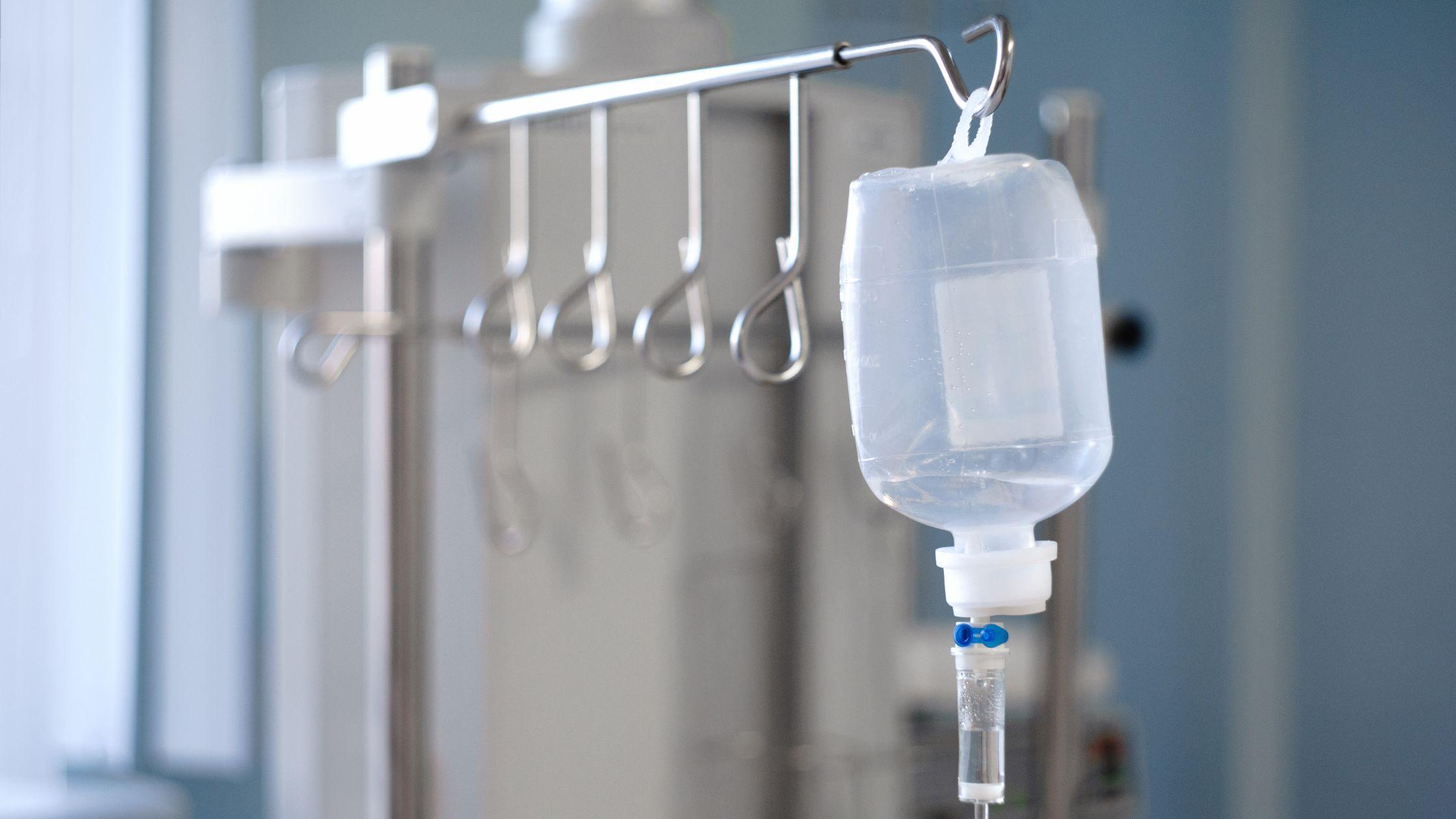The medical field is constantly growing and the most important factor for patient care is the safe and efficient delivery of medications. In this fast-paced and ever-changing environment, infusion pumps have emerged as indispensable tools, enhancing patient safety and streamlining medication administration.
This blog serves as a comprehensive handbook, designed to equip healthcare professionals with the knowledge and skills necessary to navigate the intricacies of infusion pumps effectively. This blog aims to bridge the gap between theory and practice providing practical insights best practices and expert advice to optimize patient safety and ensure the smooth delivery of medications.
Within this blog, we will know all the fundamental principles of infusion pump technology exploring the various types of pumps available their functionalities and their specific applications in different healthcare settings. From volumetric pumps to syringe pumps, we cover the range of devices that are integral to modern healthcare.
However, this handbook goes beyond technicalities. It also emphasizes the importance of patient safety and risk management in infusion pump usage. We address common challenges, potential errors, and strategies for mitigating risks to ensure the utmost safety for patients. Understanding the principles of medication delivery, proper pump programming, and alarm management are just a few of the topics covered to ensure accurate and timely administration.
Whether you are a nurse, pharmacist, technician or any healthcare professional involved in medication delivery this handbook serves as an essential resource to elevate your understanding and mastery of infusion pumps. This comprehensive guide helps you to have all the knowledge and skills necessary to optimize patient safety, improve efficiency and deliver exceptional care.
So, let us embark on this journey together, as we delve into the art of infusion, empowering healthcare professionals to make a profound impact on patient safety and medication delivery.
Introduction to Infusion Pumps
Infusion pumps are medical devices designed to deliver fluids medications and nutrients directly into a patient’s body in a controlled and precise manner. These devices have become integral to modern healthcare playing a crucial role in various medical settings including hospitals, clinics and home care.
At their core, infusion pumps operate based on the principle of delivering substances at a predetermined flow rate, ensuring accurate dosing and maintaining therapeutic effectiveness. They offer a wide range of applications, from administering intravenous fluids to delivering complex medication regimens, such as chemotherapy or pain management therapies. The primary components of an infusion pump include a pump mechanism a control interface a reservoir or cartridge for holding the medication or fluid and a delivery system (such as tubing and needles) to transport the substance to the patient’s body.
Types of Infusion Pumps
There are various types of infusion pumps available each designed to meet specific medical needs. The main types of infusion pumps include:
- Volumetric Infusion Pumps: Also known as peristaltic pumps volumetric pumps are commonly used for delivering large volumes of fluids such as saline solutions or blood products. These pumps use rollers or rotating discs to compress the tubing, propelling the fluid forward at a controlled rate.
- Syringe Infusion Pumps: Syringe pumps are designed for precise and controlled delivery of small volumes of medications. They use a motorized syringe mechanism to push the plunger and administer the medication accurately. Syringe pumps are particularly useful when administering medications with low dosages or for infusion in pediatric patients.
- Patient-Controlled Analgesia (PCA) Pumps: PCA pumps allow patients to self-administer pain medications within predetermined safety limits. These pumps provide a button or trigger that the patient can press to receive a prescribed dose of pain medication. PCA pumps help manage pain effectively and give patients more control over their pain management.
- Ambulatory Infusion Pumps: Ambulatory pumps are portable devices that allow patients to receive continuous medication infusion while remaining mobile. These pumps are lightweight, compact, and often have features like adjustable flow rates and programmable dosing schedules. Ambulatory pumps enable patients to receive treatments outside of healthcare facilities, promoting convenience and mobility.
- Enteral Infusion Pumps: Enteral pumps are specifically designed for delivering nutrition and medications directly into the gastrointestinal tract. These pumps have specialized features to handle enteral feeding tubes and ensure accurate delivery of enteral formulas and medications.
- Implantable Infusion Pumps: Implantable pumps are surgically implanted devices that deliver medication directly into specific body areas, such as the spinal cord or the intrathecal space. These pumps are used for long-term pain management or the administration of medications that require targeted delivery.
- Insulin Infusion Pumps: Insulin pumps are specially designed for individuals with diabetes to deliver insulin continuously throughout the day. These pumps provide precise insulin dosing and can be programmed to match the individual’s insulin needs, promoting better blood sugar control.
Usage of Infusion Pumps
Infusion pumps have a wide range of applications in healthcare settings. They are primarily used for the controlled and precise administration of fluids, medications, and nutrients into a patient’s body. Some common uses of infusion pumps include:
- Intravenous (IV) Fluid Administration: Infusion pumps are extensively used for delivering fluids such as saline solutions, electrolytes, blood products, and other intravenous therapies. The pumps ensure a constant and accurate flow rate, maintaining proper hydration, and balancing electrolyte levels.
- Medication Administration: Infusion pumps play a crucial role in delivering medications, including antibiotics, pain management drugs, chemotherapy agents, and various other intravenous medications. By controlling the infusion rate, these pumps help maintain therapeutic drug levels and optimize treatment outcomes.
- Parenteral Nutrition: In cases where patients cannot consume food orally, infusion pumps are used to deliver specialized nutrition solutions directly into the bloodstream. These solutions contain essential nutrients, vitamins, minerals, and calories required for patients who are unable to obtain adequate nutrition through the digestive system.
- Patient-Controlled Analgesia: These pumps allow patients to self-administer pain medication within prescribed limits. By providing patients with a button or trigger, they can control the timing and dosage of pain relief medication, promoting effective pain management and improving patient comfort.
- Chemotherapy: Infusion pumps are commonly used in chemotherapy treatments to deliver chemotherapeutic drugs at controlled rates. This ensures the accurate dosing of medications and minimizes potential side effects by maintaining consistent drug concentrations in the bloodstream.
- Epidural and Regional Anesthesia: Infusion pumps are utilized in epidural and regional anesthesia techniques to deliver local anesthetics or pain medication near specific nerves or areas of the body. These pumps enable continuous and controlled administration of anesthesia, ensuring prolonged pain relief during surgical procedures or childbirth.
- Home Care: Infusion pumps have found their way into home care settings, enabling patients to receive necessary treatments outside of healthcare facilities. Home infusion therapy such as intravenous antibiotic administration or parenteral nutrition can be safely and effectively managed using portable infusion pumps allowing patients to have a better quality of life while receiving necessary medical care.
Infusion Pump Accessories
Infusion pump accessories are auxiliary components or devices that complement the functionality and use of infusion pumps. These accessories are designed to enhance safety, convenience, and efficiency during the infusion process. Here are some common infusion pump accessories:
- IV Tubing: IV tubing is used to connect the infusion pump to the patient and facilitate the delivery of fluids or medications. It typically includes components such as a spike for accessing the IV bag or bottle, a drip chamber for fluid visualization, and connectors for attachment to the patient’s IV access site.
- Infusion Sets: Infusion sets include various components, such as a disposable tubing system, a needle or catheter for accessing the patient’s vein, and connectors for attaching to the infusion pump and IV bag or bottle. These sets are available in different lengths and configurations to accommodate different patient needs and infusion requirements.
- Extension Sets: Extension sets are additional lengths of tubing used to extend the reach of the infusion system. They can be useful when the patient needs mobility or when the pump needs to be placed at a distance from the patient.
- Syringes: Syringes are commonly used with syringe infusion pumps for delivering medications. These disposable, calibrated devices are available in different sizes to accommodate various medication volumes. Syringes are typically equipped with luer lock or luer slip connectors to securely attach to the pump.
- Filters: Filters are accessories that can be incorporated into the infusion line to remove particulate matter or air bubbles, ensuring the purity and safety of the infused fluids or medications. Filters help prevent occlusions and minimize the risk of adverse reactions caused by contamination.
- Infusion Pump Stands and Mounts: Infusion pump stands or mounts are used to hold and secure the infusion pump during use. These accessories provide stability, allow for easy adjustment of the pump’s height and position, and ensure the pump remains within convenient reach for healthcare professionals.
- Protective Covers: Protective covers are disposable or reusable sleeves or bags that encase the infusion pump, providing an additional layer of protection against spills, contamination, and potential damage. They help maintain the cleanliness and integrity of the pump during use.
- Alarms and Alert Systems: Some infusion pumps may have optional alarm systems or alert accessories to notify healthcare providers of potential issues, such as occlusions, low battery levels, or infusion completion. These features ensure timely intervention and enhance patient safety.
Infusion Pump Safety
Infusion pump safety is of paramount importance to ensure the well-being of patients and the effective delivery of medications or fluids. Here are some key aspects of infusion pump safety:
- Proper Training and Education: Healthcare professionals should receive comprehensive training on the specific infusion pump models they will be using. They should be knowledgeable about pump operation, programming, troubleshooting, and safety features. Ongoing education and updates on infusion pump technology are essential to maintain proficiency.
- Adequate Pump Selection: Selecting the appropriate infusion pump for a specific therapy or patient condition is crucial. Consider factors such as the required flow rate, volume accuracy, compatibility with medications, and patient-specific needs. Ensuring compatibility between the medication delivery system and the pump is essential for safe and effective administration.
- Accurate Programming and Calibration: Careful and precise programming of infusion pumps is vital to avoid dosage errors. Double-checking the programmed settings, including flow rates, volumes, and infusion duration, helps prevent under- or overdosing. Regular calibration and verification of pump accuracy are necessary to maintain reliable performance.
- Monitoring and Alarms: Infusion pumps often have built-in safety features, including alarms and alerts. Healthcare providers should carefully monitor the infusion process, promptly respond to any alarms, and investigate the cause. Alarms can indicate issues like occlusions, air bubbles, low battery levels, or the completion of the infusion.
- Preventing Medication Errors: To reduce the risk of medication errors, healthcare professionals should verify the medication name, concentration, and dosage before programming the pump. Double-checking the medication label, using barcode scanning technology if available, and employing the “five rights” of medication administration (right patient, right medication, right dose, right route, right time) are critical safety practices.
- Maintenance and Regular Inspections: Infusion pumps should undergo regular maintenance and inspections to ensure proper functioning. This includes checking for damage, leaks, or wear and tear on tubing, connectors, and seals. Battery life and power supply should also be regularly evaluated to prevent unexpected interruptions in therapy.
- Adherence to Infection Control Practices: Proper infection control measures, such as hand hygiene, aseptic technique during tubing changes, and appropriate disinfection of pump surfaces, help prevent the spread of infections. Following facility-specific infection control protocols is essential for patient safety.
- Documentation and Communication: Accurate and complete documentation of infusion pump settings, medication administration, and any relevant patient information is crucial for the continuity of care and effective communication among healthcare providers. Clear communication between healthcare team members ensures the safe and coordinated use of infusion pumps.
Troubleshooting & Maintenance of Infusion Pumps
Troubleshooting and maintenance of infusion pumps are essential to ensure their optimal performance and patient safety. Here are some key points regarding troubleshooting and maintenance:
- Troubleshooting: Familiarize yourself with the user manual of the pump and the troubleshooting guide provided by the manufacturer. Address any error messages or alarms immediately. Check for common issues like occlusions, air bubbles, or loose connections. Verify that the pump is properly calibrated and programmed with the correct settings. Ensure that the infusion line is free from kinks, twists, or obstructions. If the issue persists, contact the manufacturer’s technical support or biomedical engineering department for further assistance.
- Maintenance: Follow the manufacturer’s recommended maintenance schedule and guidelines. Regularly inspect the infusion pump for any physical damage, leaks, or wear and tear. Replace damaged components promptly. Clean the exterior of the pump using appropriate disinfectants and follow facility-specific infection control protocols. Ensure that the battery or power source is functioning correctly and replace or recharge as needed. Calibrate the pump periodically or as recommended by the manufacturer to maintain accurate dosing and flow rates. Keep a record of maintenance activities, including inspections, calibrations, and any repairs performed.
- Staff Training: Provide comprehensive training to healthcare professionals on the use, troubleshooting, and maintenance of infusion pumps. Ensure that staff members understand the different pump models and are familiar with the specific features and functionalities of each. Educate users on common troubleshooting steps and when to seek technical support.
- Documentation: Maintain thorough documentation of any troubleshooting steps, maintenance activities, and repairs performed on the infusion pumps. Keep a record of any incidents or issues encountered and their resolutions. Document any changes in pump settings, including flow rates and dosages, along with appropriate approvals.
Infusion Pumps From Leading Indian Manufacturers
BM-VP-500
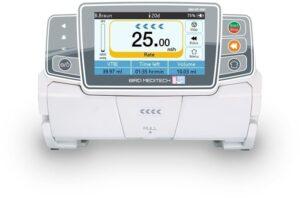
Bird Meditech is is widely recognized as a prominent industry leader in manufacturing and globally distributing infusion pumps. One of their flagship products, the BM-VP-500. Bird Meditech BM-VP-500, stands as a testament to their excellence. This volumetric infusion pump boasts double sensors capable of detecting both air bubbles and pressure. It has been meticulously designed to deliver medication with exceptional precision, ensuring accurate and dependable infusion rates. In order to prioritize patient safety, the BM-VP-500 includes an anti-bolus function, effectively preventing the sudden administration of large medication volumes.
To further mitigate the risk of medication errors, the BM-VP-500 incorporates a Drug Error Reduction System (DERS) function. This invaluable feature substantially minimizes the likelihood of inaccuracies during medication delivery. With an IP level of IP34, this infusion pump provides ample protection against liquid ingress, making it suitable for diverse healthcare environments.
For enhanced convenience and efficiency, the BM-VP-500 offers an optional Wi-Fi feature, enabling seamless connectivity and remote monitoring of the pump. Moreover, the pump boasts a robust storage capacity of over 5000 entries, facilitating comprehensive documentation of infusion data for healthcare professionals.
In terms of safety and vigilance, the BM-VP-500 is equipped with a comprehensive array of alarms. These alarms include VT Bl near end, V TBI infused, Check upstream, High pressure, Door open, No power, Battery nearly empty, Battery empty, KVO finished, Drops error, Air bubble, Standby time expired, and System errors. By promptly notifying healthcare providers of potential issues, these alarms enable swift intervention and prevent potential complications during the infusion process.
AMS 737
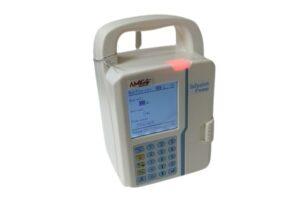
The AMS 737 infusion pump, manufactured by Amigo Medical Systems, is a versatile and reliable device suitable for adults, pediatrics, and neonates. Its curvilinear peristaltic pump design ensures accurate and controlled medication delivery. The pump can be used with any IV set, providing flexibility and compatibility in various medical settings.
One of the notable features of the AMS 737 is its built-in thermostat, which maintains the warmth of the IV tubing during infusion. This feature maximizes the efficiency of the infusion process and helps prevent the adverse effects of cold fluids on patients. The pump also incorporates an anti-free-flow function, enhancing safety by preventing the uncontrolled flow of medication in case of accidental disconnection.
The AMS 737 features a user-friendly interface, allowing healthcare professionals to monitor the infusion parameters in real-time. The display provides comprehensive information, including infused volume, bolus rate, bolus volume, and Keep-Vein-Open (KVO) rate. This real-time data enables accurate monitoring and adjustment of infusion parameters as needed.
With its long-lasting battery, the AMS 737 operates for more than 4 hours without requiring external power, providing mobility and uninterrupted infusion. The pump also allows for on-the-fly adjustment of the flow rate without interrupting the infusion process, ensuring seamless and precise medication delivery.
IP 501 Infusion Pump
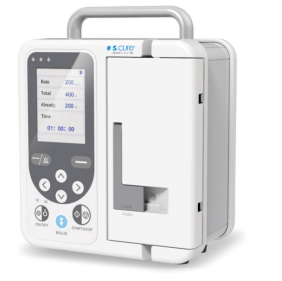
Silverline Meditech Pvt. Ltd., manufactures the IP 501 Infusion Pump, an advanced and adaptable medical device that is well-suited for various healthcare applications. The pump is specifically designed to be battery-operated and easily portable, allowing the user to use it in home or clinical settings as well as hospital environments.
Equipped with large LCD display navigation buttons and indicators, the IP501 allows a clear and readability view of infusion parameters. The large LCD provides real-time monitoring capabilities by health care professionals monitoring the process during its entire course. This innovation ensures precise control along with patient safety. The navigated keypad has four directional keys for accurate adjustment of infusion parameters like flow rate and volume.
Due to its versatility compatibility with most standards of IV sets, this pump offers immense flexibility in the deployment of medical procedures. The IP501 is also a programmable infusion pump enabling customization requirements to suit individual needs depending on various parameters of the patient. A particular feature of this pumping equipment ensures virtual customized medication delivery based on the actual need of the patient’s medications.
The IP 501 contains wireless connectivity enabling remote monitoring after infusion. With multiport infusion capability, the IP501 canadminister multiple infusions simultaneously to facilitate ease of workflow within the context of multifaceted medication administration.
The pump includes an infusion pump with flow control, ensuring accurate and consistent flow rates. It is also specifically designed for enteral nutrition, making it an ideal choice for the administration of nutritional fluids.
The IP 501 is suitable for both human and veterinary medicine. It has a drug library feature, making it particularly suitable for the administration of chemotherapy drugs. The pump also incorporates an occlusion detection feature, preventing infusion in case of blockage in the IV line, thereby ensuring patient safety.
AKAS INFUMAX 5005
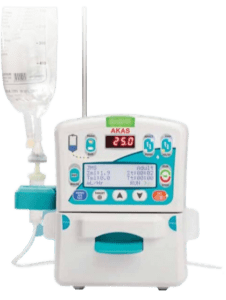
AKAS INFUMAX 5005, manufactured by AKAS Medical Equipment [AKAS Infusions], is a reliable and versatile infusion pump. The device includes a rotating clamp, providing flexibility for mounting on movable poles or rails, enhancing ease of use and convenience.
Equipped with a three-level adjustable alarm and a flow-reducing occlusion alarm, the AKAS INFUMAX 5005 ensures the safety of the infusion process by alerting healthcare professionals to potential issues or obstructions. The lever operation and free flow protection further contribute to the pump’s user-friendly design and safety features.
The AKAS INFUMAX 5005 is compatible with any IV tubing, offering flexibility and convenience in healthcare settings. It is designed to withstand tough conditions, ensuring durability and longevity. The portable design of the pump enhances its usability and mobility, facilitating efficient and reliable medication delivery.
The device includes simple controls, allowing for easy operation and intuitive usage. The AKAS INFUMAX 5005 can be upgraded to a Wi-Fi interface, enabling seamless connectivity and remote monitoring, further enhancing its functionality and convenience for healthcare professionals.
Volux
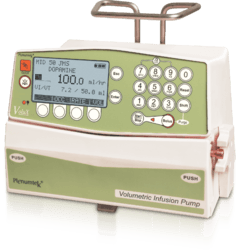
Volux Infusion Pump, manufactured by Plenum Tech Pvt. Ltd., is a reliable and efficient volumetric infusion pump. It incorporates various features that ensure safety, accuracy, and ease of use.
The keypad locking facility prevents accidental changes to the infusion parameters, ensuring the reliability and consistency of the medication delivery. The pump also includes moisture protection measures, safeguarding it against potential damage caused by exposure to liquids.
Electrical safety is a priority in the design of Volux, minimizing the risk of electrical hazards and ensuring the well-being of both patients and healthcare professionals. The audio and visual alarms provide timely notifications and alerts, ensuring prompt response and intervention in case of any issues or errors during the infusion process.
Overall, Volux Infusion Pump is a dependable and safe device, designed to meet the diverse needs of healthcare professionals in delivering precise and accurate medication infusions.
Introducing Medzell: Empowering Indian Medical Devices in Emerging Markets
In the world of healthcare, Medzell stands as a futuristic B2B platform, promoting Indian medical devices in emerging markets. This innovative platform connects manufacturers, suppliers, and distributors, facilitating access to cutting-edge medical technologies. Medzell plays a vital role in bridging the gap between quality medical devices and the healthcare providers who need them. Explore the possibilities and benefits Medzell offers in the realm of infusion pumps and other medical devices.
Conclusion
In conclusion, infusion pumps are indispensable tools in healthcare settings. They enable precise fluid delivery, enhance patient safety, and streamline medication administration. By exploring the various types of infusion pumps, understanding their features and functionalities, and staying updated on the latest industry trends, you can make informed decisions to optimize patient care. Additionally, paying attention to infusion pump safety, troubleshooting skills, maintenance practices, and comprehensive staff training will further contribute to a culture of excellence in healthcare. Stay informed, be proactive, and embrace the advancements in infusion pump technology to unlock a world of possibilities in delivering superior patient care.
